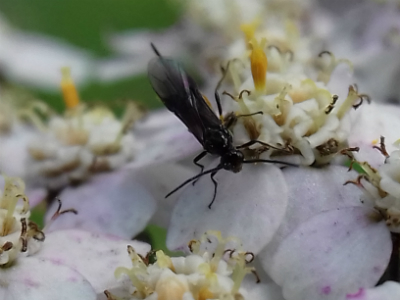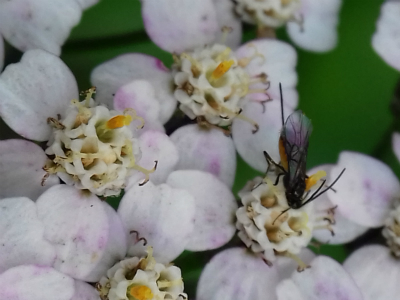Diptera.info :: Identification queries :: Other insects, spiders, etc.
Who is here? 1 guest(s)
|
3mm Braconidae? -> Braconinae Sp. ?
|
|
| Ray Perry |
Posted on 05-10-2017 20:09
|
|
Member Location: Flensburg, Germany. Posts: 592 Joined: 26.09.17 |
Can somebody please ID this or at least confirm that it is Braconidae. body 3-4mm, horn 2-3mm feeding on yarrow blossom. 15.50pm, 12th Sept. 2017, Flensburg, Germany. More detail might be seen on the video:- https://www.youtu...1wGjp7Cc80 (I removed Siricidae from the subject request after Jürgen pointed out that it's too small to be one.) Ray Perry attached the following image:  [40.56Kb] Edited by Ray Perry on 26-10-2021 14:37 |
|
|
|
| Ray Perry |
Posted on 05-10-2017 20:15
|
|
Member Location: Flensburg, Germany. Posts: 592 Joined: 26.09.17 |
from above
Ray Perry attached the following image:  [89.48Kb] |
|
|
|
| Ray Perry |
Posted on 05-10-2017 20:17
|
|
Member Location: Flensburg, Germany. Posts: 592 Joined: 26.09.17 |
venation
Ray Perry attached the following image:  [101.35Kb] |
|
|
|
| Ray Perry |
Posted on 05-10-2017 20:18
|
|
Member Location: Flensburg, Germany. Posts: 592 Joined: 26.09.17 |
long antennae.
Ray Perry attached the following image:  [117.47Kb] |
|
|
|
| Tony Irwin |
Posted on 05-10-2017 20:23
|
|
Member Location: Norwich, England Posts: 7320 Joined: 19.11.04 |
Not Siricidae - I'd say Braconidae
Tony ---------- Tony Irwin |
|
|
|
| Ray Perry |
Posted on 05-10-2017 20:26
|
|
Member Location: Flensburg, Germany. Posts: 592 Joined: 26.09.17 |
Thanks Tony, I was wondering about that possibility and that's why I showed the image with the waist. Ray |
|
|
|
| Juergen Peters |
Posted on 06-10-2017 05:35
|
|
Member Location: northwest Germany Posts: 14332 Joined: 11.09.04 |
Hello Ray, Ray Perry wrote: I was wondering about that possibility Siricidae are large to very large wasps. Urocera gigas, the largest Hymenoptera of central Europe, belongs to the Siricidae. You won't find a Siricid with a length of 3-4 mm, more likey 30-40 mm. 
Best regards, Jürgen -=-=-=-=-=-=-=-=-=-=-=-=-=-=-=-= Juergen Peters Borgholzhausen, Germany WWW: http://insektenfo... -=-=-=-=-=-=-=-=-=-=-=-=-=-=-=-= |
| Ray Perry |
Posted on 06-10-2017 11:54
|
|
Member Location: Flensburg, Germany. Posts: 592 Joined: 26.09.17 |
Thanks Jürgen, So would you also guess at Braconidae? Any suggestion as to the Subfamily? Warm Regards Ray |
|
|
|
| Ray Perry |
Posted on 06-10-2017 22:25
|
|
Member Location: Flensburg, Germany. Posts: 592 Joined: 26.09.17 |
Could this be Atanycolus Sp. ? |
|
|
|
| Juergen Peters |
Posted on 07-10-2017 04:21
|
|
Member Location: northwest Germany Posts: 14332 Joined: 11.09.04 |
Ray Perry wrote: Could this be Atanycolus Sp. ? Looks more like Bracon sp.. Best regards, Jürgen -=-=-=-=-=-=-=-=-=-=-=-=-=-=-=-= Juergen Peters Borgholzhausen, Germany WWW: http://insektenfo... -=-=-=-=-=-=-=-=-=-=-=-=-=-=-=-= |
| Ray Perry |
Posted on 07-10-2017 08:43
|
|
Member Location: Flensburg, Germany. Posts: 592 Joined: 26.09.17 |
Thanks Jürgen Yes, I thinks that's it - a great help  it matches other images of Bracon Sp. on the internet. it matches other images of Bracon Sp. on the internet.Below is a similar looking male of what I think is also Bracon Sp. On broccoli flower buds in my garden. 15.47pm, 21st Sept. 2017. Flensburg, Germany. You can see he has no ovipositor when he goes into flight at the end of this video:- https://www.youtu...l6QZ2eokjo Best Regards Ray Ray Perry attached the following image:  [19.28Kb] |
|
|
|
| Jump to Forum: |













